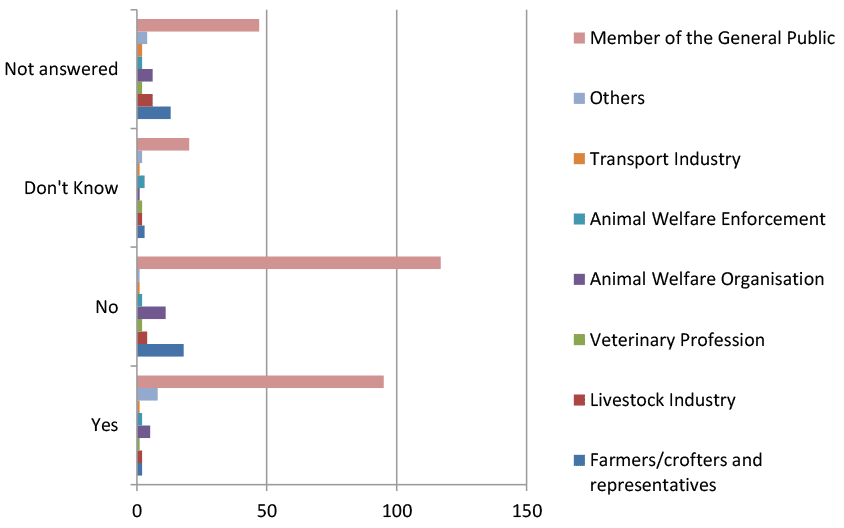Welfare of animals during transport - consultation: summary report
Analysis of the responses received to the full public consultation, between 4 December 2020 to 26 February 2021, of the Farm Animal Welfare Committee's opinion on the welfare of animals during transport.
Question 7
Do you agree with the Scottish Government’s position on space allowances for animals in transport and proposed course of action? Please provide any further relevant information.
It is the view of the Scottish Government that the stocking density of animals in transport is a key aspect of their welfare, and this includes providing sufficient headroom. If animals are not provided with enough space and headroom there can be adverse animal welfare impacts, including distress and discomfort as well as injuries and bruising during transport.
We are keen that our requirements reflect the latest evidence and expert understanding and we agree that proposals for future regulatory reforms should include FAWC’s species-specific headroom allowances. We agree in principle that allometric systems could be used to calculate stocking density, which could include taking into account each animal’s weight individually. We consider that more work is needed to explore how this more precise approach could be applied in practice.

Of the 306 responses to this question, 37.9% were in favour of the Scottish Government’s position on space allowances for animals in transport and proposed course of action. 51.0% were not in favour and 11.1% did not express a view.
While many of the respondents agreed that stocking densities affect the welfare of transported animals there were a number who considered the “rationale behind these (minimum) headroom heights is unclear” (unnamed organisation). Others suggested that the use of the heights promoted by FAWC to deliver better welfare outcomes would “not work consistently as it takes no account of different breeds within species” (unnamed organisation) whereas others suggested that space allowances may need to be defined for different seasons and environmental conditions “to minimise heat stress … when ambient temperature is expected to be high or journeys will be long” (Scottish Animal Welfare Commission).
Other organisations agreed the principle of minimum heights, but suggested that “as explained in the EFSA[1] scientific opinion (of 2011) it is recommended to determine the height of the deck or compartment as the space between the withers of the tallest animal per deck” (OneKind).
The British Equine Veterinary Association and some unnamed equine organisations did not agree with the proposed headroom for equines, instead believing “that the current requirement to set out clearance above the highest point of the withers (75cm) should be retained”. Four Paws UK contended that the minimum height should be calculated from the highest point of the back of an animal and suggested minimum heights for a range of livestock species.
A number of respondents agreed the soundness of using allometric principles to define suitable space allowances citing that “experienced stockmen and hauliers use this principle, without thinking about it” at each loading (Blackhall Farms). However, many of these respondents contended that the “practicalities of putting this into practice is very difficult” (Robertsons, Orkney Ltd).
A number of organisations from the farming and transport industries suggested that “increasing space allowances could lead to issues of vehicle stability and also lead to animals injuring themselves” (P&A Kemp). Others from these sectors suggested that increased room could be detrimental to animal welfare by “increasing the propensity of animals to jump on the backs of other animals in the group” (unnamed farm business). In the words of one respondent “Analysis of Livestock in Transit insurance claims at the NFU Mutual Kirkwall Agency over the past 20 years has found no instances where claims have resulted from animals having too little space, whereas there have been claims where the animals were loosely loaded” (J&R Stanger).
Some respondents also considered that if there is a need to redesign or adapt vehicles there could be implications for their stability potentially leading to animal welfare issues. Others suggested that requiring newer, higher vehicles could also have unintended consequences around existing road infrastructure e.g. low bridges.
The Road Haulage Association provided calculations based on the FAWC recommendations suggesting a “dramatically reduced” level of associated stocking in transport. The Association has suggested this would have a “huge impact on livestock haulage devastating effect on the livestock industry … an impact on abattoir output and to the overall supply chain”.
Contact
There is a problem
Thanks for your feedback